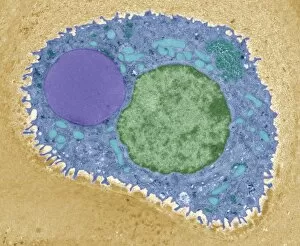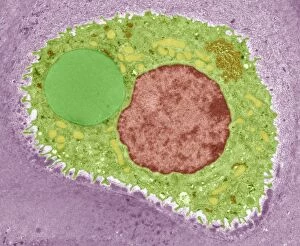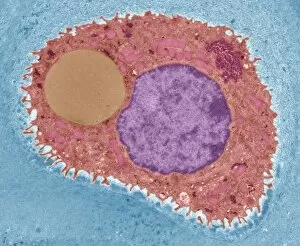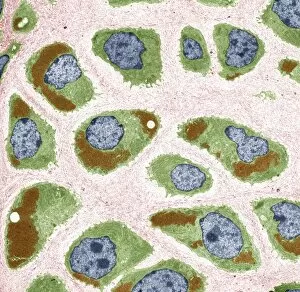Extracellular Matrix Collection
The extracellular matrix (ECM) is a complex network of molecules that provides structural support and regulates cellular behavior in various tissues
For sale as Licensed Images
Choose your image, Select your licence and Download the media
The extracellular matrix (ECM) is a complex network of molecules that provides structural support and regulates cellular behavior in various tissues. In cartilage, the ECM plays a crucial role in maintaining its unique properties. Under the powerful lens of transmission electron microscopy (TEM), we can observe the intricate details of cartilage cells (TEM C014 / 1433, TEM C014 / 1434, TEM C014 / 1432). These images reveal their elongated shape and numerous organelles within. Additionally, TEM allows us to examine clusters of cartilage cells closely (Cartilage cells, TEM). The close proximity suggests cell-cell communication and coordination for proper tissue function. Switching gears to scanning electron microscopy (SEM), we capture stunning images of hyaline cartilage - a type of cartilage found in joints. SEM unveils its smooth surface texture and dense collagen fibers that make it resilient yet flexible (Hyaline cartilage, SEM). Returning to TEM once again, we delve deeper into the world of individual cartilage cells. The high-resolution images showcase their distinct morphology and highlight their importance in maintaining tissue integrity (Cartilage cells, TEM). Lastly, our attention shifts towards an essential player in ECM remodeling - the lysyl oxidase enzyme molecule. This molecule is responsible for cross-linking collagen fibers within the ECM to provide strength and stability. Multiple views emphasize its significance in maintaining tissue structure and function (Lysyl oxidase enzyme molecule). These captivating glimpses into the extracellular matrix shed light on its critical role in supporting healthy tissues like cartilages while emphasizing the complexity involved at both cellular and molecular levels.





